
Every social media article claims the virtues of engagement.
Trouble is, many fall short in explaining how it helps brands drive business results.
Maximizing engagement is critical because it’s the missing link between strangers and loyal renters.
It’s a foundation of awareness and trust that helps people emotionally attach to your property (as opposed to the one down the street with similar pricing and amenities).
And on Facebook specifically, engagement dictates how many people you’ll ultimately be able to reach or influence.
In this article, we’ll examine three ways to increase Facebook engagement, backed up by data, that will help you reach more renters.
‘EdgeRank’ is the name of Facebook’s organic algorithm that determines who (or which of your fans and friends) sees what (pieces of content or updates).
It’s similar to how Google indexes and ranks content for organic search, but has it’s own rules that come down to engagement (instead of links) as a primary factor in reach (or exposing your content to the most people possible).
But before diving into the tips and tricks of how to defeat EdgeRank, it’s critical to understand how it works.
The harsh reality of Facebook marketing is that without engagement, people will never see any of your updates (no matter how much you paid to acquire them in the first place).
EdgeRank is a complex algorithm made up of many moving parts, but there are three main ‘categories’ it’s analyzing:
Pay extra attention to this last point, because your content type has a huge impact on reaching the most people possible.
For example, BuzzSumo recently analyzed over 1 billion posts from 30 million Facebook brand pages to see what’s working, and what’s not.
And their findings paid extra attention to ‘weight’ specifically. Here’s what they discovered:
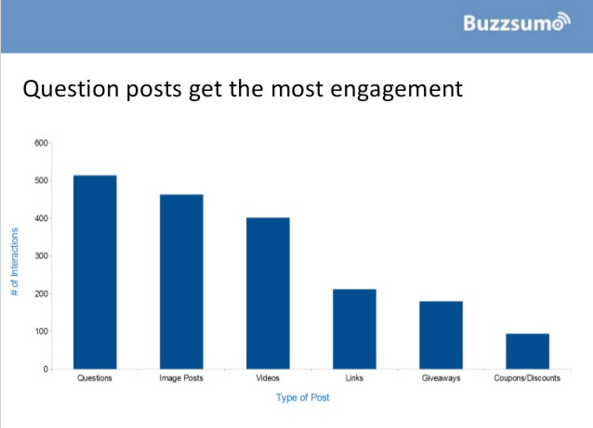
Questions, image posts, and videos tend to be the most important. While coupons or discounts are great for grabbing impulse purchases, they’re not so good at driving engagement (and therefore, reach).
This is backed up by our own experience, where image can vastly outperform coupons when done correctly:

When the engagement of a post skyrockets like that, your effective ‘reach’ follows suit. Open up your own Facebook Insights right now to see evidence of this.
Start by looking at the most recent popular posts, and you’ll begin seeing the pattern of engagement driving reach. Yours will look similar to the example below, where the ratios of drop significantly once engagement slows down.
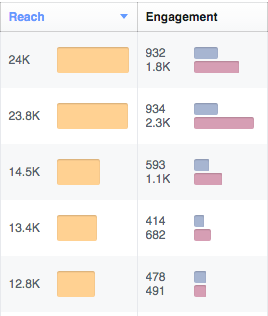
Another way to view this trend is through the Reach tab in your Facebook Insights. Here, when you stack the Post Reach image on top of the Reactions, Comments and Shares (or engagement), you’ll see their peaks and valleys line up quite nicely.

Believe it or not, this is good news. It means Facebook marketing (and most social media marketing techniques in general) is logical and straightforward after all. It removes the ‘man behind the curtain’ mystique, and instead shows you a clear path to success.
Now that you understand what EdgeRank is, and how it works, let’s look at how to defeat it.
The key to mastering Facebook’s EdgeRank is through increasing engagement as much as possible.
That’s evident not only in the types of updates you should be posting (with questions, images and videos at the top), but also in the approach or style behind those updates.
Start by getting personal. Questions should ask people’s personal opinions on relevant topics they care for deeply. For example, you can start with the following list to get people talking:
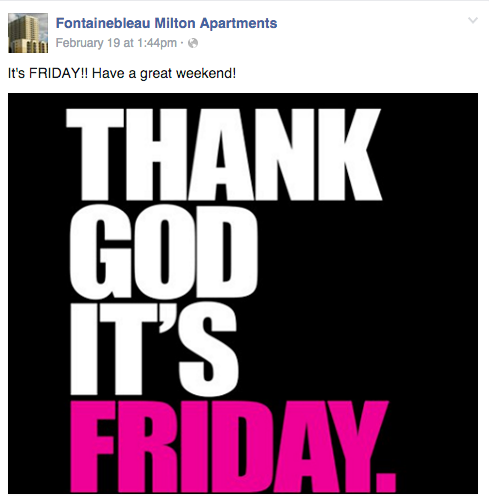
Just make sure you keep them brief. BuzzSumo’s data showed that the shorter the message, the better. The conclusion is that people want to engage on Facebook, not consume endless amounts of content.
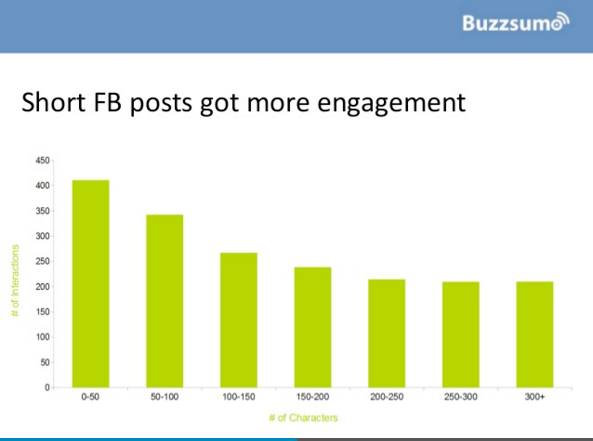
Another report from Buddy Media backs this up, showing that you can increase engagement by 27% by keeping posts to less than 80 characters.
Why? People's attention span are short - so get to the point.
Where you post content and how you share it with Facebook also matters. Instagram’s acquisition a few years ago bodes well for the service, with data showing that images from Instagram had 23% greater engagement.
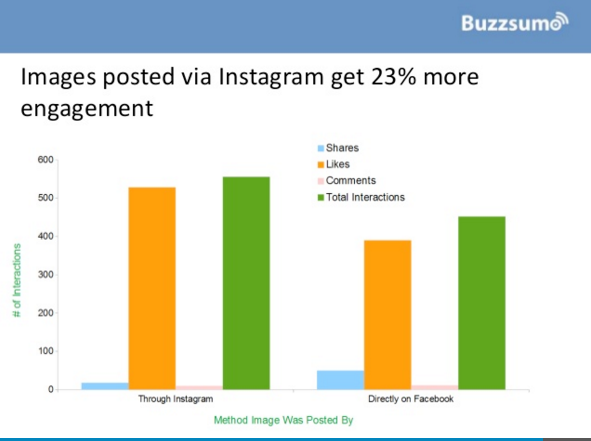
Image choice impacts engagement rates as well, with some of the best results featuring images of other people (especially faces!).
Keep this in mind when taking content from your website or blog, making sure that whatever images grabbed by Facebook’s Open Graph are the best for driving engagement.
If not, you might want to consider manually finding different images. Pexels, Free Images, and Unsplash are helpful free alternatives for high quality stock images.
Aspirational images also work well because they unite people behind some common bond (while also keeping word count to a minimum).
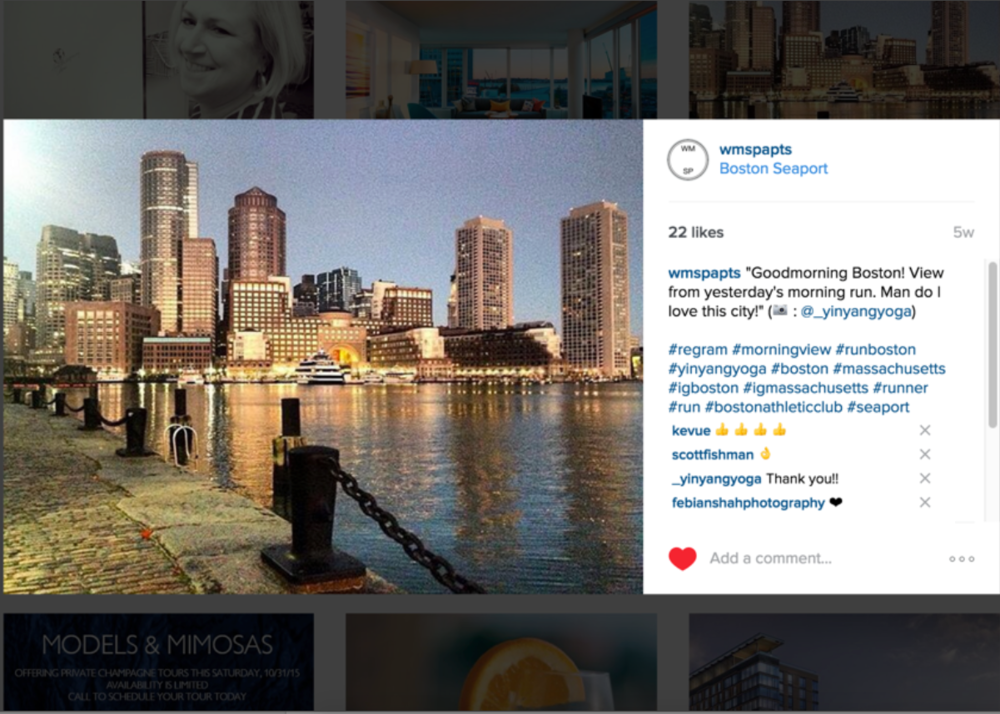
Interestingly, how you post a content update also has a big impact, with more ‘weight’ commonly given to posts made directly inside Facebook (as opposed to a third-party tool or other service not owned by them).
For example, videos uploaded directly to Facebook vastly outperform ones originating with YouTube.
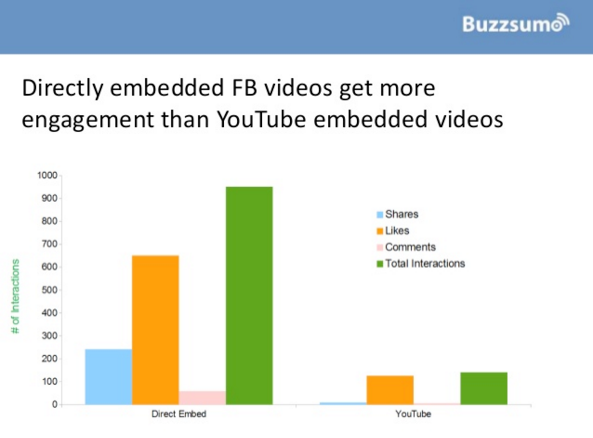 The extra ten minutes it takes to upload your video to each destination, instead of auto-posting or embedding content from one social network directly to the other, is apparently worth it.
The extra ten minutes it takes to upload your video to each destination, instead of auto-posting or embedding content from one social network directly to the other, is apparently worth it.
But when should you post them? Read on...
Dan Zarella is a ‘social media scientist’ who used to work at HubSpot, analyzing millions of results every day in order to boil down what’s working, from what’s not.
In 2014, Dan wrote the Hierarchy of Contagiousness, which dives deep into some of the biggest trends and patterns he’s seen when trying to increase social media results.
One of the biggest tips included contra-competitive timing, which said to avoid the most popular times when posting to avoid competing with the onslaught of other messages. Even weekends were preferable he said, which completely contradict most traditional ‘best practices’.
BuzzSumo’s data again backs up this approach, showing that there’s a lot to gain by going against the grain.
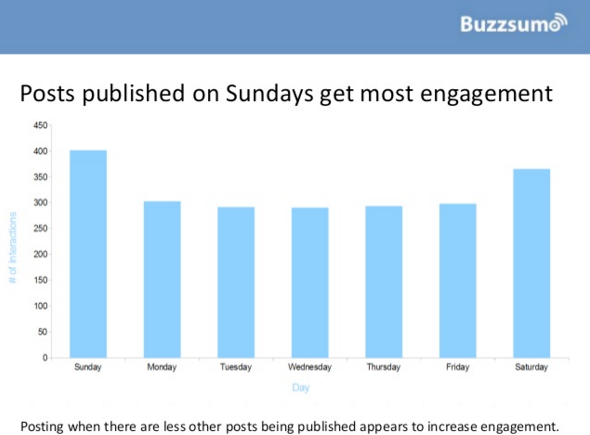
Not only are weekends some of the best times to post updates, but late nights actually work well too.
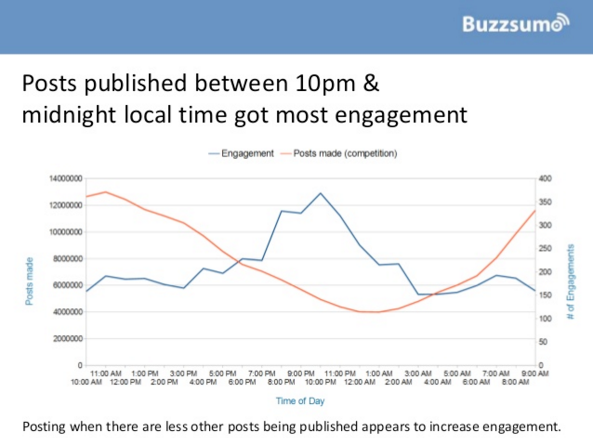
While every brand tries to squeeze in the majority of their posts during the mid-morning hours, you can increase results significantly by scheduling posts to go out after work, when people are at home and casually browsing around.
This focus on timing to avoid the competition works because it helps you stand out from the crowd. Information fatigue is real. And it can negatively impact your results.
The Technology Adoption Lifecycle curve explains how cultures accept new technology at different rates, while also highlighting the differences between their behaviors and personalities.
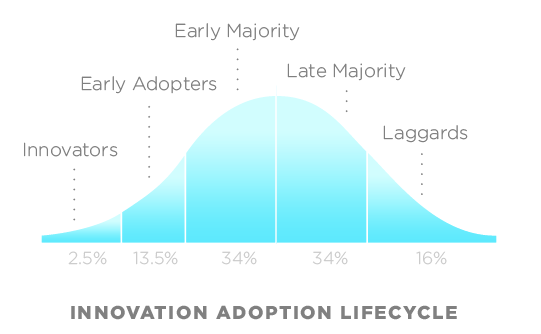
Most of the Facebook audience can now be classified as the Early and Late Majority.
They typically aren’t as hyperactive on social networks - as opposed to the Innovators or Early Adopters back when it was only available on college campuses - which means their preferences need to be taken into account.
For example, Dan’s book provided test results showing that posting less frequently (every other day) actually helped increase engagement.
In other words, improve the signal to noise ratio by posting less frequent, but higher quality work. This is beautifully illustrated in an infographic from Kissmetrics:
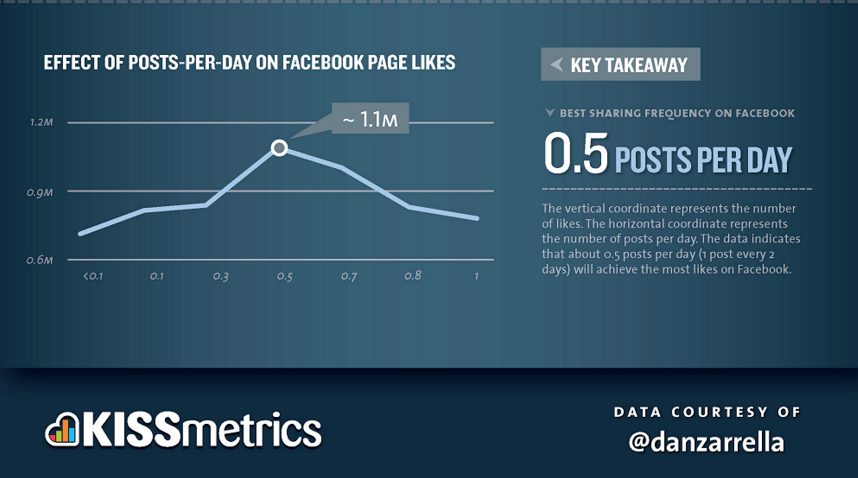
BuzzSumo’s results also touched on information fatigue, highlighting a surprising fact that posts without hashtags outperform those that do have them.
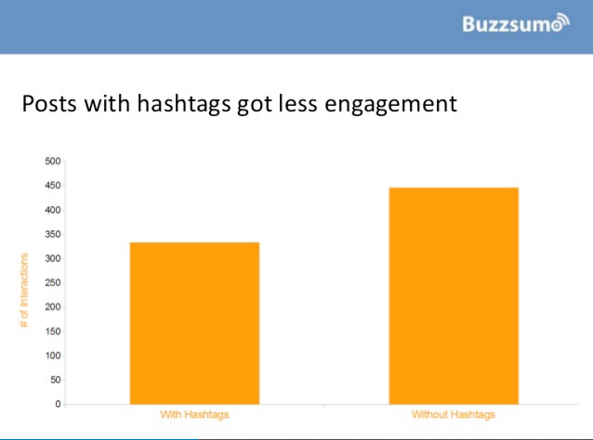
While this seems counterintuitive, because hashtags were originally created to help increase engagement, it makes sense as they’ve been abused for years by well-intentioned marketers.
Information fatigue might be causing people to ‘tune off’ when they now see posts loaded with hashtags.
The key to reaching more renters, is through increasing engagement first.
By getting more people to view, like, comment, and care about your brand, the better chance you’ll have at reaching the most fans, friends, and friends of friends possible.
Personalized questions, images and videos tend to see the highest engagement - just don’t neglect the approach or timing when publishing those updates, as they also greatly impact performance.
And while it might be tempting to post when the most people are online, it might not always be the best for engagement because of the sheer amount of competition you’re up against.
The good news is that Facebook marketing isn’t a mysterious, mystical process.
To the contrary, data has shown that it’s actually more logical and rational than many other forms of promotion.
These Stories on Social Media

San Diego, CA
600 B St.
San Diego, CA 92101

Austin, TX
600 Congress Ave.
Austin TX 78701

Washington, DC
1875 Connecticut Ave NW
Washington, DC 20009
Copyright © 2024 AM Digital, LLC Terms of Service Privacy Policy
Street Address
City, ST 00000
Call us: 1-800-COMPANY
(800-000-0000)